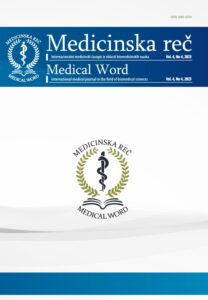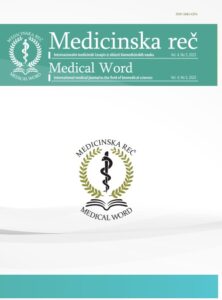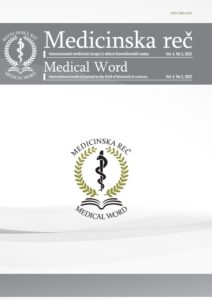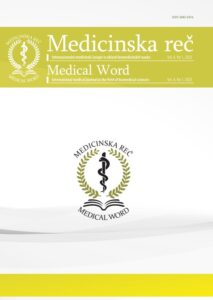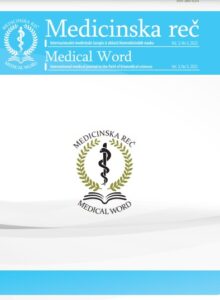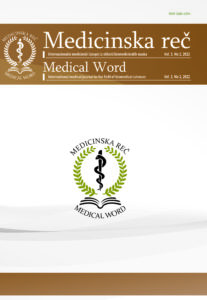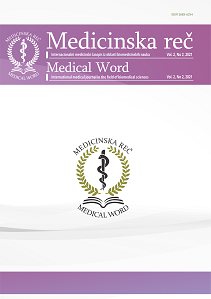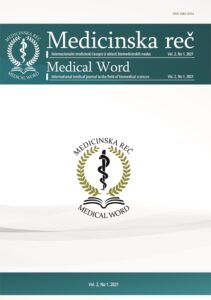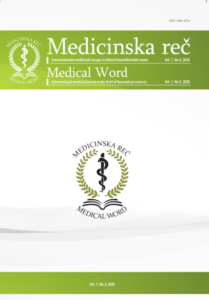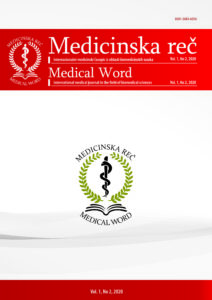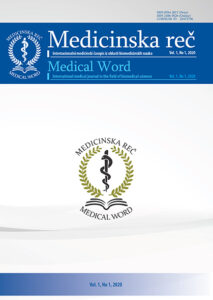Processing and storage of blood components during the COVID-19 pandemic
Ana Antić, Sanja Živković Đorđević, Marija Jelić, Miodrag Vučić, Nebojša Vacić, Bela Balint
Med Word 2020; 1(3): 114–118
https://doi.org/10.5937/medrec2003114A
Abstract
The spread of the COVID-19 virus has a strong influence on blood collection, maintaining a stable supply of all blood components and the safety of the transfusion itself. SARS-CoV-2 has a long incubation period (1-14 days, on average 5-6 days, longest reported 24 days) and causes asymptomatic infection in a large number of patients, which is a great challenge in a recruitment of blood donors and achieving a safe transfusion. Precise recommendations and precautions have been adopted regarding the criteria for temporary refusal of blood donors during the COVID-19 pandemic, organization of mobile teams and collection sites, disposal of medical waste, examination of potential donors and mandatory body temperature measurement. Although transmission of COVID-19 via blood and blood components has not been demonstrated, some countries have also introduced mandatory NAT testing for SARS-CoV-2 as a part of blood screening testing. Also, proactive measures have been taken, such as temporary storage of blood in quarantine for 14 days after collection, while special attention is paid to efficient management of blood component stocks and development of a collection plan, in order to avoid shortage of certain blood components or their expiration.
The first step in this regard is to revise the measures which have the aim for improving the usability of blood components, ie reducing waste of stocks, which primarily refers to the temporary extension of the shelf life of blood components. Extending the shelf life of erythrocytes (longer than 35 to 49 days, which is defined at the national level) should be considered as early as possible, because once a shortage of erythrocytes occurs, they will be issued long before the expiration date. Previous studies have not shown significant side effects of erythrocyte transfusion with extended shelf life, so it is possible to consider the flexibility of blood processing and erythrocyte storage conditions with mandatory internal process validation and component quality control. The shelf life of platelet concentrate should be extended from 5 days to 7 or even 8 days, with mandatory bacteriological testing or pathogen inactivation. Another option to increase the platelet supply for prophylactic purposes is to reduce the platelet dose by dividing the existing components. Frozen fresh plasma has the longest shelf life (up to 3 years), so maintaining stable reserves is much safer than for cellular components. Liquid plasma (never previously frozen) has a shelf life of 7-40 days, and can be used in conditions of reduced freezer capacity, shortage of staff working on blood processing or for the production of convalescent plasma.
Pathogen inactivation of plasma and platelets allows 3-6 log reduction of SARS-CoV-2 and MERS-CoV. The decision to introduce some of the methods of pathogen inactivation should be made taking into account the costs and resources required for implementation. For countries that do not have pathogenic inactivation already in routine practice, its rapid introduction is a big task. For now, the risk of SARS-CoV-2 transmission through the blood appears to be very low, although our understanding of the virus and behavior during a pandemic will improve over time. In this regard, pathogen inactivation of convalescent plasma should also be considered.
Key words: COVID-19, transfusion, blood components, pathogen inactivation
References
- Stanworth SJ, New HV, Apelseth TO, Brunskill S, Cardigan R, Doree C, Germain M, Goldman M, Massey E, Prati D, Shehata N, So-Osman C, Thachil J. Effects of the COVID-19 pandemic on supply and use of blood for transfusion. Lancet Haemtaol 2020; 7: e756-64.
- Allain JP, Bianco C, Blajchman MA, Brecher ME, Busch M, Leiby D, Lin L, Stramer S. Protecting the blood supply from emerging pathogens: the role of pathogen inactivation. Transfus Med Rev 2005; 19: 110-26.
- AuBuchon JP. Meeting transfusion safety expectations. Ann Intern Med 2005; 143: 537-8.
- COVID-19 global literature on coronavirus disease, 2020. Available at: https://search.bvsalud.org/global-literature-on-novel-coronavirus-2019-ncov/. (Accessed on December 21, 2020).
- Guan WJ, Ni ZY, Hu Y, Liang, WH, Ou CQ, He J, et al. Clinical characteristics of coronavirus disease 2019 in China. N Engl J Med 2020; 382: 1708-20.
- Cai X, Ren M, Chen F, Li L, Lei H, Wang X. Blood transfusion during the COVID-19 outbreak. Blood Transfus. 2020; 18(2): 79-82.
- Chinese Society of Blood Transfusion. Recommendations for blood establishments regarding the novel coronavirus disease (COVID-19) outbreak. Available at: http://eng.csbt.org.cn/portal/article/index/id/606/cid/7.html (Accessed on: December 17, 2020).
- AABB Update: impact of 2019 novel coronavirus and blood safety. Available at: http://www.aabb.org/advocacy/regulatorygovernment/Documents/Impact-of-2019-Novel-Coronavirus-on-Blood-Donation.pdf. (Accessed on: December 16, 2020).
- FDA Important information for blood establishments regarding the novel coronavirus Outbreak.Available at: https://www.fda.gov/vaccines-blood-biologics/safety-availability-biologics/important-information-blood-establishments-regarding-novel-coronavirus-outbreak. (Accessed on: December 16, 2020).
- European Centre for Disease Prevention and Control. Coronavirus disease 2019 (COVID-19) and supply of substances of human origin in the EU/EEA. Available at: https://www.ecdc.europa.eu/sites/default/files/documents/covid-19-supply-substances-human-origin.pdf. (Accessed on: December 20, 2020).
- Chang L, Zhao L, Gong H, Wang L, Wang L. Severe Acute Respiratory Syndrome Coronavirus 2 RNA Detected in Blood Donations. Emerg Infect Dis 2020; 26(7): 1631-33.
- Kwon SY, Kim EJ, Jung YS, Jang JS, Cho NS. Post-donation COVID-19 identification in blood donors. Vox Sang 2020; 115(8): 601-2.
- Stanojković Z, Antić A, Vučić M, Mačukanović Golubović L. Preparation, use and clinical efficiency of blood products. Bilt Transfuziol (Lectures and Abstract Book) 2018; 63(1-2): 30-3.
- Trivella M, Stanworth SJ, Brunskill S, Dutton P, Altman DG. Can we be certain that storage duration of transfused red blood cells does not affect patient outcomes? BMJ 2019; 365: l2320.
- Shah A, Brunskill SJ, Desborough MJ, Doree C, Trivella M, Stanworth SJ. Transfusion of red blood cells stored for shorter versus longer duration for all conditions. Cochrane Database Syst Rev 2018; 12(12): CD010801.
- Slichter SJ, Bolgiano D, Corson J, Jones MK, Christoffel T, Bailey SL, Pellham E. Extended storage of buffy coat platelet concentrates in plasma or a platelet additive solution. Transfusion 2014; 54(9): 2283-91.
- Slichter SJ, Corson J, Jones MK, Christoffel T, Pellham E, Bailey SL, Bolgiano D. Exploratory studies of extended storage of apheresis platelets in a platelet additive solution (PAS). Blood 2014; 123(2): 271-80.
- Stanojković Z, Antić A, Stanojković M, Jelić M. Primena aditivne solucije za pripremu i čuvanje trombocita. Bilt Transfuziol 2014; 60(1-2): 43-5.
- Stolla M, Fitzpatrick L, Gettinger I, Bailey SL, Pellham E, Christoffel T, Slichter SJ. In vivo viability of extended 4°C-stored autologous apheresis platelets. Transfusion 2018; 58(10): 2407-13.
- Slichter SJ, Kaufman RM, Assmann SF, McCullough J, Triulzi DJ, Strauss RG, et al. Dose of prophylactic platelet transfusions and prevention of hemorrhage. N Engl J Med 2010; 362(7): 600-13.
- Klein HG. Pathogen Inactivation: Beyond the Consensus Conference. Toronto, Canada 2009.
- Antić A, Stanojković Z, Mačukanović-Golubović L, Jelić M. Ispitivanje faktora koagulacije u zamrznutoj svežoj plazmi inaktivisanoj primenom riboflavina i ultravioletnog zračenja. Vojnosanit Pregl 2012; 69(1): 22-6.
- Allain JP, Bianco C, Blajchman MA, Brecher ME, Busch M, Leiby D, Lin L, Stramer S. Protecting the blood supply from emerging pathogens: the role of pathogen inactivation. Transfus Med Rev 2005; 19: 110-26.
- Chang L, Yan Y, Wang L. Coronavirus Disease 2019: Coronaviruses and Blood Safety. Transfus Med Rev 2020; 34(2): 75-80.
- Chang L, Zhao L, Gong H, Wang L, Wang L. Severe Acute Respiratory Syndrome Coronavirus 2 RNA Detected in Blood Donations. Emerg Infect Dis 2020; 26(7): 1631-3.
- Keil SD, Ragan I, Yonemura S, Hartson L, Dart NK, Bowen R. Inactivation of severe acute respiratory syndrome coronavirus 2 in plasma and platelet products using a riboflavin and ultraviolet light-based photochemical treatment. Vox Sang 2020; 115(6): 495-501.


